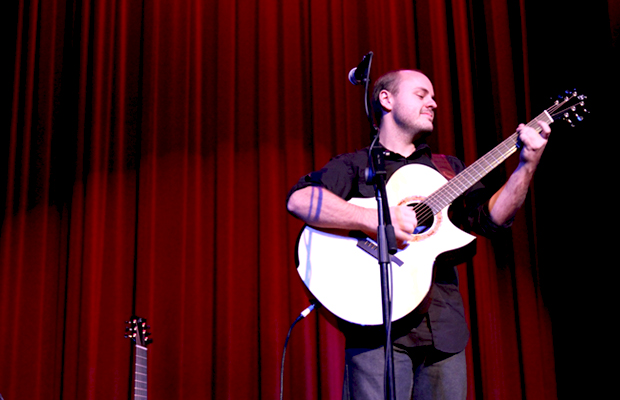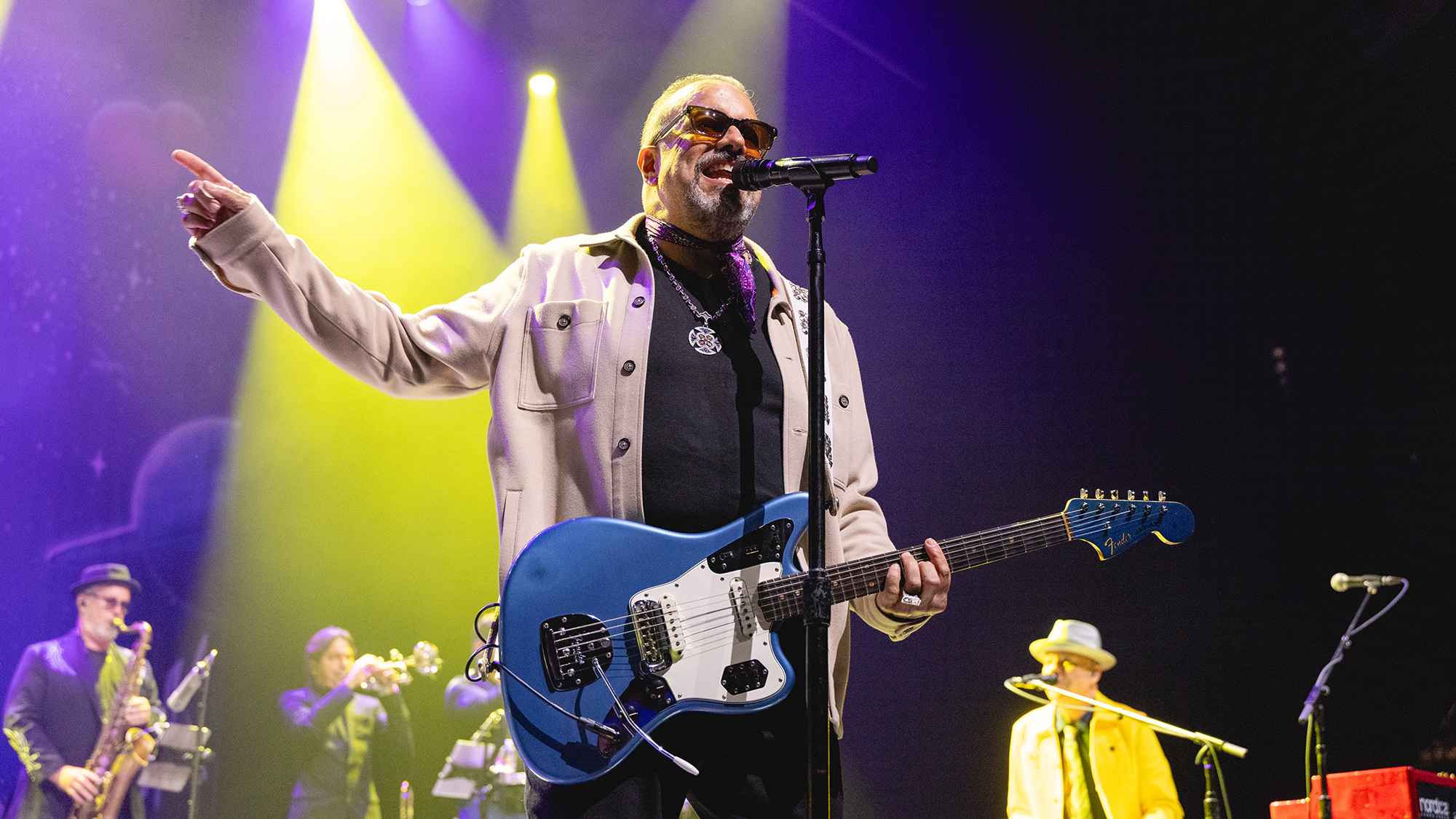Interview: Andy McKee Discusses New EP 'Mythmaker' and More

I can remember the first time I heard Andy McKee’s music.
I was in college, and walked into a friend’s room to find him and a bunch of kids (all guitar players) huddled around a computer.
“Check this out,” one of them said.
There on the screen was this guy with an acoustic guitar, slapping and tapping the side of it like it was a drum, while simultaneously playing this amazing melody.
We all looked at the computer, eyes fixated. This was our introduction to Andy McKee, and the tune was “Drifting.”
As the video ended, the room went quiet, and I think we all said silently to ourselves, "OK, maybe this guitar thing is not for me."
That was 2006, and “Drifting,” which became one of YouTube’s first ultra-viral videos, was no flash-in-the-pan for McKee.
All the latest guitar news, interviews, lessons, reviews, deals and more, direct to your inbox!
Since then he’s carved his own path in the instrumental music world, releasing a catalog of material and gaining nods from everyone from Prince to Dream Theater (McKee has collaborated with both).
We had the opportunity to sit down with McKee before his sold out show at Yoshi’s in San Francisco. Prior to taking the stage, he treated us to a couple exclusive performances and filled us in on his upcoming EP, Mythmaker, and much more in the interview below.
Find out more at andymckee.com.
Tell us about what influenced your upcoming EP, Mythmaker.
Well, 2012 was really busy year, so I wanted to take 2013 off the road. I spent most of last year working on new music. We also had another baby and moved into a new house, so I was busy on the home front and working on music in the meantime.
I had this idea to do EPs. I’ve heard of other artists going this route and it sounded appealing to me. I actually have a hard time writing music when I’m touring; when I’m living in hotels, it can be tough to get into the creative mind. So I thought of doing EPs, which would allow me to put music out more frequently – maybe in smaller chunks, but still more frequently.
Mythmaker is the first EP. It’s got a solo baritone guitar piece, a solo piece on standard guitar, and it’s actually got a solo piano piece, too.
You played the piano?
Yeah, yeah. There’s also a track with piano, guitar, acoustic guitar, and electric guitar.
Oh?
Yeah, getting freakin’ ridiculous here! It was at the very end, actually. I recorded the whole song, and I thought, maybe I should put an electric guitar solo in. That’s such a can of worms, you know? But it felt right and I’m really happy with the guitar solo. It’s not a shred-fest at all–it’s more like David Gilmore than Steve Vai. But, anyway, I hope people are into it.
Is that the first electric guitar that you’ve ever tracked on a record?
It is, actually. Other than that, I’ve done a couple YouTube videos for fun.
Do you think you’ll catch any criticism for playing electric?
Well, there has been a little bit, even on Facebook. I posted a status that said something like, “I just recorded an electric guitar solo, oh my God,” and some people responded with “You know, you really shouldn’t give up on the thing that made you famous.” I’m like, “What? I’m not quitting acoustic guitar.”
In any case, I’m a big fan of all kinds of music. I’ve never just listened to acoustic guitar, so I felt compelled to try it. We’ll see what happens going forward. Maybe there will be more multi-instrument stuff. I’ve been talking with Eric Johnson and John Bertucci, two of my favorite guitar players I’ve had the good fortune to meet and become friends with. We’re talking about collaborating, so we’ll see if that comes together. I have no idea if that will be me on acoustic guitar, or if it will be more like a progressive rock thing. Who knows?
That would be awesome.
We’re going to do it. We just have to.
I’m not sure what the future holds, but I’m at the point where I’ve given up on this idea that I need to be this virtuoso acoustic guitar player. I’ve felt almost bound to that mind frame, and that can really stifle you. Why get caught up with that idea? It’s better to let creativity and music happen–that’s really what it’s all about. That was a big realization I had this last year. I don’t really feel like I have to write the next big acoustic guitar showcase piece or something. I really want to write nice music more than ever. That’s the real focus.
Check out our exclusive video of Andy McKee playing "The Reason" from his upcoming EP Mythmaker.
So, can tell us about some of the acoustics that you play?
Sure, yeah. In 2004, I was competing in this Canadian guitar festival. I think I got 2nd place, but I also happened to meet this guy, Michael Greenfield, a luthier from Canada. He had some guitars on display. I checked them out and was absolutely blown away. First–just seeing them–they look like works of art. And then playing them, I was totally amazed by how they sounded and how well they played.
We finally started working together just a few years ago, and that’s all I play now. I’ve got two baritone guitars and two standard pitch guitars from him. He finally caved in to building me a harp a couple years ago, too!
Wow. Was that his first?
Yep, and only so far. These guitars have a fanned fret guitar neck, which helps with the intonation of the instrument. They also have two bevels, one on the front and one in the back of the lower bout on the top side. Those just make it more comfortable to play for extended periods of time.
The bracing inside is his own design and holds up really well. He designed the guitars to have a longer scale-length for some of the detuned stuff that I do, which allows me to easily go into DADGAD or lower – even down to C or B on the low string.
Can you tell us a little about your writing process?
I like to experiment with new tunings. That’s where it kind of begins. Either I’ll discover a new one from another player, or use one I’ve never heard of and just begin to play around. Sometimes I’ll take a chord that I like and tune the guitar to it. One that was really bizarre that I came up with is used in the song “Art of Motion.” It’s this F-sharp minor 11th chord that is really big and stretched out on a regular guitar, so I took the intervals and tuned the guitar to play it like an open chord.
I’ve always liked chords – the polyphony of them, their different textures, how they resonate and how they make you feel. So discovering alternate tunings is a really a big thing for me – I have a lot of fun trying to come up with new ones. So, I’ll start there, experiment, and begin come up with a progression or riff. Then I’ll start to hear melodic ideas that could go with it, and I try to find how I can do those at the same time. Sometimes, I’ll have these percussive ideas, like in “Drifting,” where there’s a percussive idea and some chordal stuff. Then it comes time to have a melody; like a verse. I usually think of my tunes in song format, with a verse, then a chorus, you know. But then, you might want a bridge or something different.
Your melodic lines are almost like the vocal on top.
Exactly. That’s what it’s supposed to be. For me, that’s what melody is. Something that just stands out on top, something memorable. That’s why I really like players like Eric Johnson and Joe Satriani. They’re more than just really amazing guitar players – they both have a great sense of melody. That’s the kind of stuff that I really latch on to. So when I’m writing, I try to keep that happening with my music, keeping those good melodies.
It’s all very intuition-based. I know some theory, chord construction, scales and things like that, but when you’re in these altered tunings, it’s almost like you throw all that away, really. You can’t really rely on that as much.
Sometimes I’ll have ideas totally away from the instrument. I’ll be in the shower and I’ll start to hear something, so I’ll get out and go straight to the studio and try to find it on the guitar or piano. The piano has been really helpful for me lately to find ideas. It’s so black and white (laughs) – all the notes are right there. There’s a little bit of mystery when you look at a guitar, especially if you’re in a bizarre tuning. But on piano, there it is, and you can start to see your intervals and feel it out pretty easily.
Can you tell us about some of the influences that pushed you to approach the guitar in the way you do?
Well, when I was 16, I saw Preston Reed play. He was doing a guitar workshop for Washburn Guitars in Topeka, Kansas, where I’m from. I didn’t even know who he was. My cousin took me to go see him. At the time, I was just listening to electric guitar. I was way into Dream Theater and Joe Satriani and all that stuff.
When I saw him–it’s hard to even express how it felt. It looked cool and it sounded great, but I really wanted to know how to do it. I got this VHS cassette that he had out at the time, and it came with a little tablature booklet where he taught three of his tunes, I think. I just dove right in and spent a good month trying to learn one song; playing over the top of the neck until my left forearm hurt. I was playing for hours..it was intense.
When I finally learned one song, it was this huge joyous moment. That was how I got into acoustic guitar, or modern acoustic guitar–Preston Reed was the guy that got me into it. He was really a pioneer of really percussive-acoustic guitar, incorporating drumbeats while playing in a way that really hadn’t been done before.
Shortly after that, I discovered Michael Hedges in some Guitar Player magazines that I inherited from the same cousin. He gave me like 200 old magazines, and I saw this guy with a harp guitar. It was Michael Hedges. His music–maybe more than anyone else on the acoustic side of things–just resonated with me. Don Ross and Billy McLaughlin are huge influences too. Those four guys are my really, really big acoustic guitar influences.
Do you ever see yourself adding instrumentation or band members?
I might end up with musicians on the road at some point. I don’t know. That’s a whole ‘nother logistical thing, getting that all figured out. I just go where the inspiration goes. I don’t want to feel like I’ve stifled anything anymore. I want to let things flow.
Find out more at andymckee.com.
Tom Gilbert is a guitarist (and aspiring pedal steel player) living in the San Francisco Bay Area. When he’s not blogging for Acoustic Nation, eating Thai food or being obsessed with his dog, Tom does marketing and PR for music and audio companies with Mad Sun Marketing.

